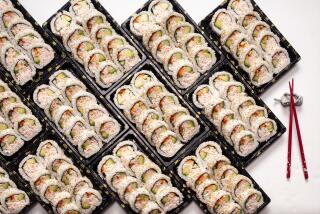A Strong Yen for Truffles
- Share via
In Japan, where truffle-eating is a newly acquired taste, plenty of people are willing to pay the price for fresh truffles. Frank Van Goethem of French F&B; Japan Inc., a truffle importer, is confident that there will always be a market for French truffles, despite the possibility of laboratory-grown truffles in the not-too-distant future.
“If they have the same quality as nature--and that’s a huge ‘if’--it will just give more people a chance to eat them,” Van Goethem says.
He sees no threat to his business. “French truffles will always be French truffles, and there will always be a market for them, and there will always be people willing to pay for them.”
Japanese imports of fresh truffles have soared from 4.4 tons in 1991 to 7.2 tons in 1995, despite the vaunted Japanese recession. Including bottled and canned goods, Japan spent $4.3 million on imported truffles in 1995, and the 1996 figure, not yet available, will probably be higher, according to Ministry of Agriculture statistics.
Japan’s appetite for truffles is growing, in part because affluence and a strong yen have allowed so many people to travel abroad and sample the world’s finest restaurants.
“They were eating it because it was expensive; now they are used to eating it,” says Chef Maurice Guillouet, whose truffle dishes include a ravioli of lobster and truffle, a Kobe beef with truffle and a truffle tart with onions and smoked bacon.
The first truffles of 1996 sold in Tokyo at $360 for about two pounds, but they were still brown and not the top-quality marbled black-and-white truffles that arrive in January, says Van Goethem. In 1995, Tokyo truffle prices hit $856 for about two pounds in December before tumbling to a mere $540 in January.
White truffles are so expensive in Japan that Van Goethem does not stock them; certain clients sometimes special-order them at more than $1,800 for about two pounds, he says.
Despite the truffle’s growing snob appeal, most ordinary Japanese have never seen one.
“Truffles usually appear as these black things that come on top of the steak that’s served at weddings in Japan, and all the guests point to this funny-looking thing and say, ‘What’s that?’ ” says Junko Ueda, a 31-year-old Paris-trained chef who creates menus for Tokyo restaurants.
Scientists Yoshinori Takano and Kazunari Inaba could change all that, though they insist they have no plans to destroy the world truffle market with a deluge of cheap hothouse fungi.
“We won’t have them lined up in the supermarket for 180 yen [$1.60],” Inaba says.
Nevertheless, now that they have succeeded in getting truffle spores to propagate, the scientists say growing the fungus should be easy and not very labor-intensive and will take less than a year. In principle, Takano says, it should be possible to produce about two pounds of truffles for $4.50.
The scientists eventually hope to sell the license to produce their patented truffles. They expect no shortage of buyers.
More to Read
Eat your way across L.A.
Get our weekly Tasting Notes newsletter for reviews, news and more.
You may occasionally receive promotional content from the Los Angeles Times.










